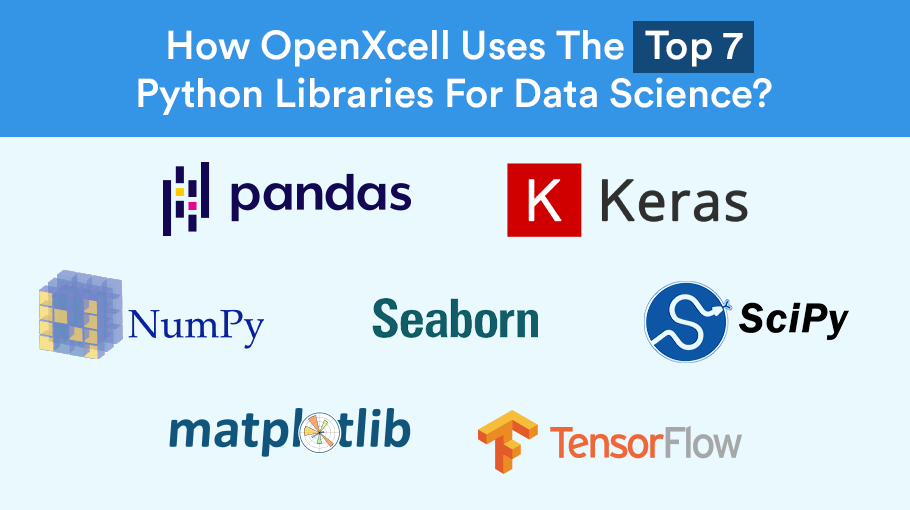Python libraries for data science: Python language is known for its usage in software development and data science. Using Python, one can predict outcomes, streamline processes, offer business intelligence insights, and automate tasks. Python has always been a charmer for data scientists.
By building Python-powered data science models, one can dip a little deeper into Python libraries for data science. Python libraries can host numerous functions, methods, and tools to design a building block. The use of libraries of Python programming language can accelerate the speed of the developer’s job.
Each Python library has its capabilities to address various goals, such as data visualization, text/image processing, neural networks, and more.
Any Python development company uses Python libraries for building various apps like prototyping, scientific research, algorithms, training tools, and deep learning models.
Here, in this blog, we will look at how OpenXcell uses the top Python libraries for data science. But before that, let’s go through the details of these Python libraries.
Top Python Libraries For Data Science
- Pandas
- Matplotlib
- TensorFlow
- Keras
- NumPy
- Seaborn
- SciPy
Let’s now have an overview of these Python libraries for Data Science to know them better.
Pandas
Pandas is known as one of the most popular Python libraries for data science. All the data scientists majorly prefer it. Pandas is essential for the data science life cycle. Pandas is a library that has around 1,200 contributors in its active community.
The primary support by Pandas is for massive operations of intense data cleaning and analysis. This library provides flexible data structures that can work with structured data.
Read This: Mobile App Development Cost Report 2020
Pandas is based on two primary data structures known as Data Frames (two-dimensional) and Series (one-dimensional). By using Pandas, the data scientists can convert data structures to Data Frame objects.
Matplotlib
Python libraries explode with great functions, tools, and packages. Besides these things, Matplotlib also provides powerful data visualization.
Matplotlib is a Python plotting library that has a massive active community of around 700 contributors. This Python data science library is massively used for data visualization with the help of plots and graphs.
TensorFlow
TensorFlow, a popular data science library, is mainly used in scientific fields for performing accurate numerical calculations. This library provides a framework that defines numerical computations. These types of computing have tensors that are computational objects that can create specific values.
TensorFlow library has a community of 1500 contributors. This library can be used for speech recognition, video detection, time-series analysis, and building apps with text analysis.
Keras
Keras is known as the fanciest machine learning library written in Python. It offers effective methods for developing neural networks.
Keras provides facilities for visualizing graphs, simplifying models, processing datasets, and more. This library is potentially equipped to run on top of Theano, CNTK, and TensorFlow.
Read This: Industry Leading Mobile App Design Trends for 2020 & Beyond
Keras is developed with a primary focus of allowing quick experimentation. The backend infrastructure is being used to create and perform operations and computationally graph.
NumPy
NumPy is a library that is a combination of both Python and Numerical. It supports numerical computation for scientific apps.
NumPy is an array-processing package that offers highly professional multi-dimensional objects that are called tools and arrays.
By providing multi-dimensional arrays, functions, and operators, NumPy eliminates the slowness problem. This library has received around 18,000 GitHub comments and 700 community contributors.
Seaborn
Seaborn, a Python data visualization library that is built on the top of the Matplotlib library. Seaborn is a library that is integrated with Pandas. It provides a high-level interface for eye-catching statistical graphs and drawing information.
Seaborn focuses on making data visualization an essential part of understanding and exploring data. It can check the relationships among various variables.
Seaborn internally performs all the critical statistical aggregation and semantic mapping.
SciPy
SciPy is a well-known open-source Python library that is used for high-level scientific computations. SciPy has about 600 community contributors and 19,000 comments on GitHub. This library has been applied for performing various technical computations and scientific calculations.
How Does OpenXcell Use These Python Libraries For Data Science?
The team at OpenXcell uses Python libraries like Pandas to manipulate, analyze, and clean customers’ data. This data can be anything from tabular data to arbitrary matrix data to unlabelled data.
Using Python libraries, app development companies like OpenXcell also create different plots like bar graphs, scatter plots, pie plot, and more, to make data visualization a better process.
Read This: Should You Invest in Mobile App Development in 2020?
As the above examples of the use of the two most popular Python libraries, other libraries of Python are also used to perform many actions without writing any code. Each Python library contains a massive number of useful modules that can be imported for everyday programming.
OpenXcell uses some of the above-listed libraries for data transformation. Using these libraries, the data scientists of OpenXcell make it easy for companies to handle and process their essential data.
Python Libraries for Data Science: Wrap-up
The tools of the Python ecosystem have been of great help for data science work. The majority of data scientists and software engineers use Python for building ML models. The above-listed Python libraries for data science have extensive capabilities. If you prefer to have an exceptional app based on AI ML created by taking the benefits of Python libraries, you can contact OpenXcell, the Python development services provider.
